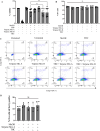The effect of cannabis-derived terpenes on alveolar macrophage function
- PMID: 39958606
- PMCID: PMC11825813
- DOI: 10.3389/ftox.2024.1504508
The effect of cannabis-derived terpenes on alveolar macrophage function
Abstract
Cannabis sativa (marijuana) is used by millions of people around the world. C. sativa produces hundreds of secondary metabolites including cannabinoids, flavones and terpenes. Terpenes are a broad class of organic compounds that give cannabis and other plants its aroma. Previous studies have demonstrated that terpenes may exert anti-inflammatory properties on immune cells. However, it is not known whether terpenes derived from cannabis alone or in combination with the cannabinoid ∆9-THC impacts the function of alveolar macrophages, a specialized pulmonary innate immune cell that is important in host defense against pathogens. Therefore, we investigated the immunomodulatory properties of two commercially-available cannabis terpene mixtures on the function of MH-S cells, a murine alveolar macrophage cell line. MH-S cells were exposed to terpene mixtures at sublethal doses and to the bacterial product lipopolysaccharide (LPS). We measured inflammatory cytokine levels using qRT-PCR and multiplex ELISA, as well as phagocytosis of opsonized IgG-coated beads or mCherry-expressing Escherichia coli via flow cytometry. Neither terpene mixture affected inflammatory cytokine production by MH-S cells in response to LPS. Terpenes increased MH-S cell uptake of opsonized beads but had no effect on phagocytosis of E. coli. Addition of ∆9-THC to terpenes did not potentiate cytotoxicity nor phagocytosis. These results suggest that terpenes from cannabis have minimal impact on the function of alveolar macrophages.
Keywords: cannabis; inflammation; macrophages; phagocytosis; terpenes.
Copyright © 2025 Greiss, Rich, McKay, Nguyen, Lefsrud, Eidelman and Baglole.
Conflict of interest statement
The authors declare that the research was conducted in the absence of any commercial or financial relationships that could be construed as a potential conflict of interest.
Figures




References
-
- Andrade-Silva M., Correa L. B., Candéa A. L. P., Cavalher-Machado S. C., Barbosa H. S., Rosas E. C., et al. (2016). The cannabinoid 2 receptor agonist β-caryophyllene modulates the inflammatory reaction induced by Mycobacterium bovis BCG by inhibiting neutrophil migration. Inflamm. Res. 65, 869–879. 10.1007/s00011-016-0969-3 - DOI - PubMed
-
- Borrelli F., Aviello G., Romano B., Orlando P., Capasso R., Maiello F., et al. (2009). Cannabidiol, a safe and non-psychotropic ingredient of the marijuana plant Cannabis sativa, is protective in a murine model of colitis. J. Mol. Med. Berl. 87 (11), 1111–1121. 10.1007/s00109-009-0512-x - DOI - PubMed
LinkOut - more resources
Full Text Sources

